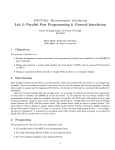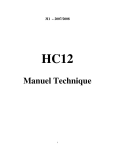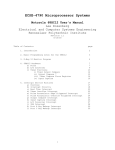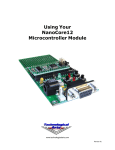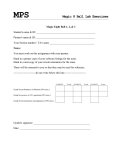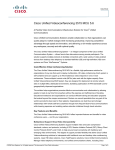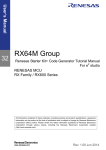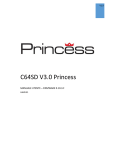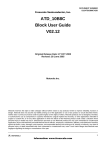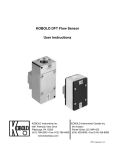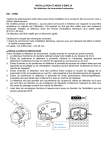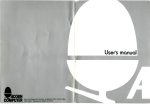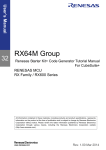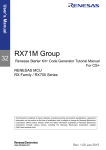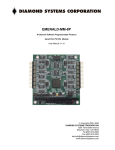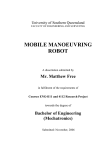Download ENG 364 Lab Manual - University of Guelph
Transcript
ENG364: Microcomputer Interfacing Laboratory Manual School of Engineering,University of Guelph Fall 2012 Embedded computer systems, which are electronic systems that include a microcomputer to perform a specific dedicated application, are ubiquitous. Our global economy, food production, transportation system, military defense, communication systems, and even quality of life depend on the efficiency and effectiveness of these embedded systems. As system engineers we play a major role in all phases of this effort: planning, design, analysis, manufacturing, and marketing. This document is orgainzed as follows: Section 1 introduces the main objectives, practices and recommendations for the ENG3640 laboratory. Section 2 introduces the M68HC12 microcontroller and its different componenets. Section 3 introduces the different lab modules that will be performed by students. Section 4 gives some guidance on how to writeup the lab report. Finally, several appendices can be found at the end of this document which are useful as a reference. 1 Laboratory Objectives and Practices The ENG364 Microcomputer Interfacing labs are an integral part of the course. The objectives of the laboratory are: • to give you practical experience with the process of design and interfacing using Motorola MC68HC12. • to help you understand and assimilate the lecture material. • to give you practical experience with the process of design and implementation of analog/digital circuits. • to give you hands-on-experience with microcontrollers such as the MC68HC12. Laboratory Practices 1. Absolutely no food or drink in the laboratories. 2. Clean up after yourselves. Put paper in the recycling bin and garbage in the trash. 3. Do not leave the door or windows open. The room will be closed after-hours if these rules cannot be followed.! Laboratory Recommendations • Labs are to be done in groups of at least 3 and at most 4 people. • The labs are to be demonstrated during the lab period on the due date. • All written lab reports are due during demonstration of the demo lab. 1 • Students are encouraged to work ahead. • Utilize the code available in your text book! 2 The MC68HC11/MC68HC12 Microcontrollers At the core of the 68HC12 is CPU12, a high-speed 16-bit evolution of the 68HC11 architecture that is designed to maintain complete source-code compatibility with the 68HC11 core. The 68HC12 fully supports all internal registers, instructions, addressing modes, and operating modes of the 68HC11. Figure 1 shows the main modules embedded in the MCU12 Microcontroller. Figure 1: The MCU12 Block Diagram and Modules Additional features and benefits include: • Up to 8 MHz bus speed at 5 V • Up to 5 MHz bus speed at 3 V • 64 new instructions, 20-bit Arithmetic Logic Unit (ALU), instruction queue, and 7 new indexed addressing modes • 16-bit data paths • 64 Kbytes of linear and paged memory addressing capability, enabling access to more than 4 Mbytes of program space and 1 Mbyte of data space 2 • Call and Return from Call (RTC) instructions for efficient paged addressing • High-level Language (HLL) optimization • Fast math capabilities (16 x 16 MUL, 32 w 16 DIV, EMACS) • Fuzzy logic instructions for simplified programming, reduced code size, and faster code execution • Low-power wait and stop modes High Performance Timer The 68HC12 timer provides flexibility, performance, and ease of use. The system is based on a free-running, 16-bit counter with a programmable prescaler, overflow interrupt, and separate function interrupts. Additional M68HC12 timer features include: • Multiple timer channels – Each channel configurable for either input capture or output compare functions • Real-time periodic interrupts • Computer Operating Properly (COP) watchdog protection against software failures • Pulse accumulator for external event counting or gated time accumulation • An optional PWM offering up to four channels and up to 16-bit PWM outputs • Optional event counter system for advanced timing operations Pulse-Width Modulation The 68HC12 Family offers a selection of Pulse-Width Modulation (PWM) options to support a variety of applications. Up to four PWM channels can be selected to create continuous waveforms with programmable rates and software selectable duty cycles from 0 to 100%. Analog-to-Digital Converter (ADC) The ADC periodically samples external analog signals and produces corresponding digital values. Typical applications are measuring analog inputs like battery voltage, temperature, pressure, and fluid levels. Linear successive approximation 8-bit or 10-bit resolution Single or continuous conversion modes Multiple result registers Selectable ADC clock Analog multiplexor allows variable number of channels with a single ADC. Evaluation Board The Dragon12-Plus2 Evaluation Board (EVB) is an economical tool for designing and debugging code for, and evaluating the operation of, the MC9S12DG256CVPE microcontroller. By providing the essential MCU timing and I/O circuitry, the EVB simplifies user evaluation of prototype hardware and software. The EVB features a prototype area, which allows custom interfacing with the microcontroller’s I/O and bus lines. The Dragon12-Plus2 evaluatin board can also accommodate various types and configurations of external memory to suit a particular application’s requirements. 3 Figure 2: The Dragon12-Plus2 Evaluation Board 3 Laboratory Assignments The course labs are structured as seven assignments. They cover the following material: • lab0: Introduction to lab equipment and M68HC12. • lab1: Introduction to Assembly Language Programming. • lab2: Parallel Port Programming. • lab3: Keypad and Switch Debouncing. • lab4: Servo motor control and LCD interfacing. • lab5: A/D converter and High-Tech Etch-a-sketch module. • lab6: Interrupt Driven I/O. • lab7: Serial RF-Communications. These labs will expose you to a range of design activities, tool functionalities and implementation technologies. Each lab has a set of deliverables. These typically include the circuit schematics, demonstration of the hardware implementation and a complete report. Due Dates There will be seven labs throughout the term. The following are the due dates. Item Lab #0 Lab #1 Lab #2 Lab #3 Lab #4 Lab #5 Lab #6 Lab #7 Takes Place Fri (Week #2) Fri (Week #3) Fri (Week #4) Fri (Week #5) Fri (Week #6) Fri (Week #8) Fri (Week #9) Fri (Week #10) Due Date Fri (Week Fri (Week Fri (Week Fri (Week Fri (Week Fri (Week Fri (Week #4) #5) #6) #8) #9) #10) #11) 4 Topic Equipment used in the Lab Introduction to MC68HC12 Controller Parallel Port Programming Keypad & Switch Debouncing Servo Motor Control/LCD Interface High-Tech Etch-a-sketch Interrupt Driven I/O Serial RF-Communication 4 Demonstration & Writeup Demonstration Be prepared to: • demonstrate the operation of the system • explain how your design works • explain how the components of the system works • answer questions related to your design. Writeup 1. Problem Statement. (a) Briefly summarize the problem solved in the lab. 2. Assumptions and Constraints 3. System Overview & Justification of Design (a) Give an overview of the system to be designed. (b) Briefly explain how the system works and reasons behind the design. 4. Hardware (a) brief explanation of the hardware. (b) for each component give a brief overview, pinout, pin description as required. (c) any required calculations for hardware components (i.e Resistor values, e.t.c). (d) complete wiring diagram for the system (multiple if necessary). (e) timing diagram if necessary. 5. Software (a) explain the function of your developed software, including subroutines. (b) software flowcharts as necessary. (c) any requierd calculations for software components (i.e., delay loops). 6. System Manual (a) give a brief user’s manual for the system. (b) include information as required on how to start the program, required user input, how to interpret results. 7. Error Analysis (a) describe any problems with the system. (b) if no problems in the final system, describe problems/errors encountered during the development and how they were resolved. 8. Performance Analysis 5 (a) assess performance of the system (how optimized it currently is, how fast it is, e.t.c). (b) suggest any desired improvements. 9. Appendix (a) include all your code with comments. (b) other relevant material as required. 5 Academic Misconduct The policy for this course is zero tolerance for any form of academic misconduct. Consultation with other students is encouraged especially on design issues. However, directly copying another student’s work or copying portions of code for example assembly language code) is an honor code violation and will result in a failing grade and may result in a failing grade in the course. Students will automatically be refered to the Director of the School and Dean of the college for action. Please refer to the regulations outlined in the student handbook regarding academic misconduct. 6 6 Appendix A – D-Bug12 Commands An HCS12 demo board may have its micro-controller programmed with the D-Bug12 monitor to support debug activities. The D-Bug12 monitor occupies the flash memory and supports a set of debug commands. The user can use these commands to display and modify register and memory contents, set breakpoints at certain locations, step through the program, and download the program onto the demo board for execution. Please refer to Chapter 3, Section 3.2 “Development Tools for the HCS12” for detailed explanation of the commands listed below in the table. Command ASM < address > BAUD < BAU DRate > BF < StartAddress >< EndAddress > [< Data >] BR [< Address >< Address > ..] BULK CALL [< Address >] G [< Address >] GT < address > Description Single line assembler/disassembler Set the SCI communication baud rate Block Fill user memory with data Set/display user breakpoints Bulk erase on-chip EEPROM Execute a user subroutine; return to D-Bug12 Go – begin execution of user program Go Till – set a temp breakpoint and begin execution of user program Display D-Bug12 command set and command syntax Load user program in S-record format Memory Display - display memory contents Memory Display Word - display memory contents Memory Modify - interactively change memory Memory Modify Word - Change Memory Contents Move a block of memory Remove individual user breakpoint Register Display – display the CPU registers Register Modify – examine/change CPU Regs Trace – execute an instruction, disassemble it and display the CPU registers Display memory contents in S-Record format Verify memory contents against S-Record Data HELP LOAD [< AddressOf f est >] MD < StartAddress > [< EndAddress >] MDW < StartAddress > [< EndAddress >] MM < Address > [< data >] MMW < Address > [< data >] MOVE < StartAdd >< EndAdd >< DestAdd > NOBR [< Address >< Address > ..] RD RM T [< Count >] UPLOAD < StartAddress >< EndAddress > VERF [< AddressOf f set >] Table 1: D-Bug12 Command Set Summary 7 7 Appendix B – D-Bug12 Commands Examples Examples of using the D-Bug12 Commands are illustrated in your text book Section 3.5.3 MD “Memory Display” The Memory Display command is used to display memory contents syntax MD <StartAddress> The following example will display the contents of memory starting at 1000. > MD 1000 1000 00 00 00 00 00 00 00 00 00 00 00 00 00 00 .... RM “Register Modify” The Register Modify command is used to examine and/or modify the contents of the CPU12 registers interactively syntax The following example will display the contents of registers > RM PC = 0000 1500 SP = 0A00 ... PC =1500 > BF “Block Fill” The Block Fill command is used to place a single 8-bit value into a range of memory locations. syntax BF <StartAddress> <EndAddress> [<Data>] The following example will fill memory from location 4000 to 4100 with zeros. > BF 4000 4100 0 CALL “Call Subroutine” The CALL command is used to execute a subroutine and return to the D-Bug12 monitor program when the final RTS of the subroutine is executed. When control is returned to D-Bug12, the CPU register contents are displayed. syntax CALL [<Address>] The following example will illustrate the CALL operation. > CALL 820 Subroutine Call Returned PC 0820 > SP 0A00 X 057C Y 0000 D = A:B 0F:F9 CCR= SXHI NZVC 1001 0000 8 BR “Breakpoint Set” The BR command is used to set a software breakpoint at a specified address or to display any previously set breakpoints. The function of a breakpoint is to halt user program execution when the program reaches the breakpoint address. When a breakpoint address is encountered, D-Bug12 disassembles the instruction at the breakpoint address, prints the CPU12’s register contents, and waits for a D-Bug12 command to be entered by the user. syntax BR [<Address> <Address> ..] The following example will illustrate the BR command. > BR 35ec 2f80 c592 Breakpoints: 35EC 2F80 C592 > BR Breakpoints: 35EC 2F80 C592 > NOBR “Remove Breakpoints” The NOBR command can be used to remove one or more previously entered breakpoints. syntax NOBR [<Address> <Address> ..] The following example will illustrate the BR command. > BR 800 810 820 830 Breakpoints: 0800 0810 0820 0830 > NOBR 810 820 Breakpoints: 0800 0830 > T “Trace” The Trace command is used to execute one or more user program instructions beginning at the current Program Counter (PC) location. As each program instruction is executed, the CPU12’s register contents are displayed and the next instruction to be executed is displayed. The following example will illustrate the Trace command. > T PC 0803 0803 SP X 09FE 057C 830001 Y 0000 SUBD D = A:B 10:00 #$0001 CCR 9 = SXHI 1001 NZVC 0000 8 Appendix C – Using D-Bug12 Routines The D-Bug12 monitor provides a few subroutines to support I/O operations. One can utilize these I/O routines to facilitate program development. The D-Bug12 currently provides access to 18 different utility routines through a table of 16-bit pointers beginning at address $EE80 as shown in Table 2. This appendix will provide you with some information that will allow you to utilize internal D-Bug12 routines. Please refer to Page 173, Section 4.8 in your text book “Using the D-Bug12 Functions to Perform I/O Operations for detailed examples. Function far main() getchar() putchar() printf() far GetCmdLine() far sscanhex() isxdigit() toupper() isalpha() strlen() strcpy() far out2hex() far out4hex() SetUserVector() far WriteEEByte() far EraseEE() far ReadMem() far WriteMem() Description Start of D-Bug12 Get a char from SCI0 or SCI1 send a char out SCI0 or SCI1 Formatted Output - binary to char Obtain a line of input from the user Convert and ASCII hex to binary int Checks for membership [0..0,a..f,A..F] Converts lower case char to upper case Checks for membership in [a..z,A..Z] Returns the length of a string Copies a null terminated string Displays 8-bit number as 2 ASCII chars Displays 16-bit number as 4 ASCII chars Setup user interrupt service routine Write a data byte to on-chip EEPROM Bulk erase on-chip EEPROM Read data from M68HC12 memory map Write data to M68HC12 memory map Vector Table Address $EE80 $EE84 $EE86 $EE88 $EE8A $EE8E $EE92 $EE94 $EE96 $EE98 $EE9A $EE9C $EEA0 $EEA4 $EEA6 $EEAA $EEAE $EEB2 Table 2: D-Bug12 Utility Routines Summary Here are a set of rules that you can follow to utilize these utility routines: 1. Calling a function from assembly language is simple. • First, push the parameters onto the stack in the proper order, loading the first or only function parameter into the D Accumulator. In other words if you have two parameters or arguments then one will be passed by the D Accumulator and the other pushed onto the stack. • Then call the function with a JSR instruction. • The code following the JSR instruction should remove any parameters pushed onto the stack. If a single parameter is stacked, a PULX or PULY instruction is one of the most efficient ways to unstack it. 2. All 8-bit and 16-bit function results are returned in the D Accumulator. Char values returned in the D accumulator are located in the 8-bit B Accumulator. 3. Boolean function results are zero for False and non-zero values for True. 10 Example #1: To output a single character to the control terminal SCI (i.e., screen) you can use the int putchar(int); function whose “Pointer Address” is located at $EE86. If the control SCI’s transmit data register is full when the function is called, putchar() will wait until the transmit data register is empty before sending the character. Adding the following instruction sequence in your program will output the character “A” to the control SCI: putchar equ ... ldd jsr ... $EE86 #‘A’ [putchar,PCR] The addressing mode used in the jsr instruction of this example is a form of indexed indirect addressing that uses the program counter as an index register. In reality, the HCS12 does not support PCR. Instead, the PCR mnemonic is used to instruct the assembler to calculate an offset to the address specified by the label putchar. The MiniIDE software supports this syntax. However, if you are using an assembler that does not support program-counter relative indexed addressing the following two instruction sequence can be used instead: ldx jsr putchar 0,x ; load the address of putchar ; call the subroutine Important: If the name of a library function is preceded by the keyword far, then it is located in the expanded memory and must be called by using the call instruction. Example #2: To retrieve a single character from the control terminal SCI use the int getchar(void); function whose pointer address is located in “$EE84”. If an unread character is not available in the receive data register when this function is called, it will wait until one is received. Because the character is returned as an integer, the 8-bit character is placed in accumulator B. Adding the following instruction sequence in your program will read a character from the SCI0 port getchar equ ... jsr ... $EE84 [getchar,PCR] Example #3: The following is a sample code for utilizing the getchar() and printf() utility routines Notice that there are two org statements. The first org statement is to set the starting address of the variables and constants at location $1000. The second org statement is to set the start address of the main program to be executed to location $1100. When you attempt to run your program you need to issue the command g $1100 in the miniIDE environment. CR LF getchar printf EQU EQU EQU EQU $0D $0A $EE84 $EE88 ; ; ; ; ORG $1000 ; Start Address of variables/constants 11 ASCII Code ASCII Code Address of Address of for Carriage Return for Line Feed Debug12 Utility Function getchar() Debug12 Utility Function printf() msg db "char pressed is %c",CR,LF,0 getnewval ORG LDX JSR $1100 getchar 0,X ; Start Address of main program ; get the character from the keyboard CMPB BEQ #$1B terminate ; Check if the char is an ESC ; jump to end of program #msg printf 0,X ; ; ; ; PSHD LDD LDX JSR terminate BRA SWI getnewval push char on stack (parameter for printf) second parameter in ACC D Load Index Reg X with printf address print message on terminal ; repeat getting new chars ; end of program (return to D-Bug12) 12 9 Appendix D – Evaluation Board “Memory Usage” The EVB’s memory usage and requirements are described below and summarized in Table 3 and Figure 3 respectively. Please refer to Page 94 Section 3.4 in the textbook for further information on the D-Bug12 Memory Map. Figure 3: The MC9S12DG256 Memory Map Address Range $0000 - $03FF $0400 - $0FFF $1000 - $3BFF $3C00 - $3FFF $4000 - $EE7F $EE80 - $EEBF $EEC0 - $EEFF $EF00 - $EF8B $EF8C - $EFFF $F000 - $FFFF Description CPU I/O Registers On-chip EEPROM On-chip SRAM (For User) On-chip SRAM (D-Bug12) D-Bug12 Code User Accessible func Table D-Bug12 customization data D-Bug12 startup code rest/interrupt table Bootloader Location on-chip (MCU) on-chip (MCU) on-chip (MCU) on-chip (MCU) on-chip Flash (MCU) Fixed Flash Table 3: Memory Map for M68HC12A4EVB 1. Important: The user has 11 KB of SRAM available for development of application programs. The user code can start at address $1000 upto $3BFF 2. Part of the on-chip EEPROM (4K) is available for user programs. Even though the HCS12DX256 parts contain 4 KB of EEPROM, only the upper 3 KB are visible, as the lower 1 KB is overlaid with the I/O registers. 13 3. The monitor program, D-Bug12, occupies locations $4000 upto $EE7F. Below is an example of a program that starts at memory location $1000 (On-chip RAM). ORG ldaa adda suba staa end $1000 $1500 $1502 $1505 $1510 ; ; ; ; ; Starting Address of Program A <== [$1500] A <== [A] + [$1502] A <== [A] - [$1505] $1510 <== [A] 14 10 Appendix E – MCU Connections Eight pin header connectors (H1 .. H8), surrounding the breadboard provide access to the MCU’s I/O and bus lines as seen in Figure 4. These connectors are located adjacent to the prototype area. Figure 4: Main Pin Headers on the Dragon12-Plus2 Board 1. Connector H1 located at upper/left of breadboard. 2. Connector H2 located at lower/left of breadboard (below H1). 3. Connector H3 located at bottom/left of breadboard. 4. Connector H4 located at bottom/right of breadboard. 5. Connector H5 located at lower/right of breadboard. 6. Connector H6 located at upper/right of breadboard. 7. Connector H7 located at top/right of breadboard. 8. Connector H8 located at top/left of breadboard. Table 4 provides a brief description of the signals. I/O Pin Usage Many I/O pins of the MC9S12DG256 on the Dragon12-Plus2 board are used by on-board peripherals, here are examples: 1. PORT A: Keypad. 15 Connector H1 H1 H1 H2 H2 H2 H2 H3 H3 H3 H4 H4 H5 H5 H6 H6 H7 H7 H8 H8 Signal Name PP3, PP2, PP1, PP0 PK3, PK2, PK1, PK0 PT0, PT1, PT2, PT3 PT4, PT5, PT6, PT7 PK5, PK4 PJ1, PJ0 PB0, PB1, PB2, PB3, PB4 PB5, PB6, PB7 PH7, PH6, PH5, PH4 PE7, PE6, PE5, PE4 PH3, PH2, PH1, PH0 PE3, PE2, PE1, PE0 PA0, PA1, PA2, PA3, PA4, PA5, PA6, PA7 PAD00, PAD08, PAD01, PAD09 PAD02, PAD03, PAD04, PAD05, PAD06, PAD07 PAD10, PAD11, PAD12, PAD13, PAD14, PAD15 PS0, PS1, PS2, PS3, PS4, PS5, PS6, PS7 PM6, PM7 PM0, PM1, PM2, PM3, PM4, PM5 PP4, PP5, PP6, PP7 Port Port Port Port Port Port Port Port Port Port Port Port Port Port Port Port Port Port Port Port Port P(0..3) K(0..3) T(0..3) T(4..7) K(4..5) J(0..1) B(0..4) B(5..7) H(4..7) E(4..7) H(0..3) E(0..3) A(0..7) AD0(0,1,8,9) AD0(2..7) AD1(0..5) S(0..7) M(6,7) M(0..5) P(4..7) Description Gen Purpose I/O Gen Purpose I/O NOT USED NOT USED Gen Purpose I/O NOT USED Gen Purpose I/O Gen Purpose I/O Gen Purpose I/O NOT USED Gen Purpose I/O NOT USED Gen Purpose I/O Analog-to-Dig Analog-to-Dig Analog-to-Dig Serial Comm NOT USED NOT USED Gen Purpose I/O Table 4: MCU Connectors J8/J9 Pin Assignments 2. PORT B: Light Emmitting Diodes (LEDs) 3. PORT H: DIP and Pushbutton Switches 4. PORT K: Liquid Crystal Display (LCD) 5. PORT P: 7-Segment Display 6. PORT AD: Light Sensor, Temp Sensor, Trimmer Pot IMPORTANT: Fortunetly, it’s unlikely that all on-board peripherals will be used by one application program. So the I/O pins on unused peripheral devices can still be used by your circuits on the breadboard. For instance, if you don’t touch the 4x4 on-board keypad, the entire port A will be available to your circuits. 16 11 Appendix F – Port Register Each port within the M68HC12 has several registers that are used to control its functionality and also give the status of the port following a read/write transaction. Table 5 provides a brief description of the regular I/O ports and their associated registers. Ports A, B, E, K can be used for Input/Output based on how the “Data Direction” register has been programmed. Port PORT A PORT B PORT P PORT H PORT E PORT K Register PORTA DDRA PORTB DDRB PORTP DDRP PORTH DDRH PORTE DDRE PORTK DDRK Description Data Register A Data Direction Register Data Register B Data Direction Register Data Register P Data Direction Register Data Register H Data Direction Register Data Register E Data Direction Register Data Register K Data Direction Register A B P H E K Address $0000 $0002 $0001 $0003 $0258 $025A $0260 $0262 $0008 $0009 $0032 $0033 Current Usage Keypad LED 7-Seg Display DIP Switches IRQ, XIRQ LCD Table 5: M68HC12 I/O Ports and Associated Registers Table 6 provides a brief description of the I/O ports (H,J) that have interrupt capability (Wakeup). Port P is very similar to ports H and J in functionality. Port PORT H PORT J Register PTH DDRH PTIH RDRH PERH PPSH PIEH PIFH PTJ DDRJ PTIJ RDRJ PERJ PPSJ PIEJ PIFJ Description Data Register H Data Direction Register H Input Register H Reduced Drive Register H Pull Devide Enable H Polarity Select Register H Interrupt Enable Register (Wakeup) Interrupt Flag Register H Data Register J Data Direction Register J Input Register J Reduced Drive Register J Pull Device Enable J Polarity Select Register J Interrupt Enable Register J Interrupt Flag Register J Address $0260 $0262 $0261 $0263 $0264 $0265 $0266 $0267 $0268 $026a $0269 $026b $026c $026d $026e $026f Table 6: I/O Ports with Interrupt Enable Capability 17 Table 7 provides a brief description of other I/O ports and registers that are used for “Real Time Interrupt” (Section 6.7 in Text Book), “Analog-to-Digital Conversion” (Section 12.3 in Text Book), and “Serial Communication”. Port RTI PORT ATD PORT SCI 0 Register RTICTL CRGFLG CRGINT ATD0CTL0 ATD0CTL1 ATD0CTL2 ATD0CTL3 ATD0CTL4 ATD0CTL5 ATDSTAT0 ATDSTAT1 PORTAD0 ATD0DR0H ATD0DR7H SCI0BDH SCI0BDL SCI0CR1 SCI0CR2 SCI0SR1 SCI0SR2 SCI0DRH SCI0DRL Description Real Time Interrupt Control Register (RTR0:RTR6) The CRG Flag Register (RTIF) The CRG Interrupt Enable Register (RTIE) Control Register 0 (Reserved) Control Register 1 (Reserved) Control Register 2 (ADPU) Control Register 3 (S8C, S4C, S2C, S1C) Control Register 4 (PRS4:PRS0) Control Register 5 (SCAN, MULT, CC, CB, CA) Status Register 0 (SCF) Status Register 1 (Reserved) Data Input (Bit7:Bit0) Result Register 0 (High Byte) Result Register 7 (High Byte) Baud Rate Register High Baud Rate Register Low Control Register 1 Control Register 2 Status Register 1 Status Register 2 Data Register High Data Register Low Table 7: M68HC12 Ports and Registers 18 Address $003B $0037 $0038 $0080 $0081 $0082 $0083 $0084 $0085 $0086 $0087 $008F $0090 $009E $00C8 $00C9 $00CA $00CB $00CC $00CD $00CE $00CF 12 Appendix G – Dragon12-Plus2 Displays The Dragon12-Plus2 Board has several means to display information by the MCU12. Here are some examples: 1. Light Emmitting Diodes, (LEDs) (connected to Port B) 2. Seven-Segment Displays, (connected to Port P) 3. Liquid Crystal Display, (connected to Port K). Each peripheral is connected to a specific port as demonstrated above. These ports can still be used as general purpose ports if the peripherals are not used. 1. If you don’t use the LCD or just unplug the LCD, the Port K will be available as well. 2. Port B drives LEDs, but if you ignore the status of the LEDs, the port B can drive any other I/O devices on the breadboard. Please refer to the “Dragon12-Plus2 Trainer, User’s Manual” for more details. LEDs: Each port B line is monitored by an LED. In order to turn on port B LEDs, the PJ1 (port J pin 1) must be programmed as output and set for logic zero. 7-Segment LED multiplexing There are 4 digits of 7-Segment LEDs on the Dragon12-Plus2 board. The type of the 7-Segment display on board is called common cathode. in an individual digit, all anodes are driven individually by an output pot and all cathodes are internally connected together. Before sending a number to a 7-Segment LED, the number must be converted to its corresponding 7-segment code depending how the 7-segment display is connected to an output port. The Dragon12-Plus2 board uses port B to drive 7-segment anodes and used PP0-PP3 (i.e., Port P) to drive common cathodes. In the next few paragraphs we will explain how to multiplex 7-segment by displaying the number 1234 on the display. By convention, the 7-Segments are called segment a, b, c, d, e, f and g, as shown in Figure 5. Figure 5: The Dragon12 7-Segment The segment a, b, c, d, e, f, g and Decimal Point are driven by (PORT B) PB0, PB1, PB2, PB3, PB4, PB5, PB6, PB7, respectively. The hex value of the segment code is shown in the following table: The schematic for multiplexing 4 digits is shown in Figure 7. 19 Figure 6: Hex Value of the numbers ‘1, 2,3, 4’ Figure 7: Multiplexing the 7-Segment Displays on the Dragon12-Plus2 Board The digits 3, 2, 1 and 0 are driven by PP0, PP1, PP2 and PP3, respectively (PORT P). The 7-Segment LED is turned on one at a time at 250 HZ refresh rate. It’s so fast that our eyes will perceive that all digits are turned on at the same time. To display the number ‘1234’ on the 7-Segment display, the following steps should be taken: 1. Output $06 to Port B, set PP0 low and PP1, PP2 and PP3 high. The number 1 is shown on the digit 3 (the leftmost digit) but other 3 digits are turned off. 2. Delay 1ms. 3. Output $5B to Port B, set PP1 low and PP0, PP2 and PP3 high. The number 2 is shown on the digit 2 but other 3 digits are turned off. 4. Delay 1ms. 5. Output $4F to Port B, set PP2 low and PP0, PP1 and PP3 high. The number 3 is shown on the digit 1 but other 3 digits are turned off. 6. Delay 1ms. 7. Output $66 to Port B, set PP3 low and PP0, PP1 and PP2 high. The number 4 is shown on the digit 0 (the rightmost digit) but other 3 digits are turned off. 8. Delay 1ms. 9. Go back to step 1. 20 13 Appendix H – Dragon12-Plus2 Keypad and DIP Switches The Dragon12-Plus2 Board has several means to send information to the MCU12. Here are some examples: 1. Hex Key Pad, (connected to Port A) 2. DIP Switches, (connected to Port H) 3. Push Buttons, (connected to Port H) Each peripheral is connected to a specific port as demonstrated above. These ports can still be used as general purpose ports if the peripherals are not used. Please refer to the “Dragon12-Plus2 Trainer, User’s Manual” for more details. DIP Switch and Pushbuttons: Port H is connected to an 8-position DIP switch. The DIP switch is connected to VCC via the RN4 (four 2.7K resistors) and RN5 (four 2.7K resistors). When Port H is programmed as an output port, the DIP switch setting is ignored. Keypad: Port A is an 8-bit bi-directional port. Its primary usage is for a 4x4 keypad. If the port is not used for the keypad, it can be used as a general purpose I/O. The Dragon12-Plus2 board uses port A to scan and test if a key has been pressed. The schematic for the keypad connection is shown in Figure 8. Figure 8: The Dragon12 Keypad Keypad Connections: • PA0 connects COL0 of the keypad. • PA1 connects COL1 of the keypad. 21 • PA2 connects COL2 of the keypad. • PA3 connects COL3 of the keypad. • PA4 connects ROW0 of the keypad. • PA5 connects ROW1 of the keypad. • PA6 connects ROW2 of the keypad. • PA7 connects ROW3 of the keypad. The following explains how to scan and test if a specific key has been pressed on the keypad. 1. Keypad scan routine sets PA3 low and PA0, PA1, PA2 high, then tests PA4-PA7. • If no key is pressed, PA4-PA7 remain high. • If PA7 = low, the key 15 (D) is pressed. • if PA6 = low, the key 11 (C) is pressed. • If PA5 = low, the key 7 (B) is pressed. • If PA4 = low, the key 3 (A) is pressed. 2. Keypad scan routine sets PA2 low and PA0, PA1, PA3 high, then tests PA4-PA7. • If no key is pressed, PA4-PA7 remain high. • If PA7 = low, the key 14 (#) is pressed. • if PA6 = low, the key 10 (9) is pressed. • If PA5 = low, the key 6 (6) is pressed. • If PA4 = low, the key 2 (3) is pressed. 3. Keypad scan routine sets PA1 low and PA0, PA2, PA2 high, then tests PA4-PA7. • If no key is pressed, PA4-PA7 remain high. • If PA7 = low, the key 13 (0) is pressed. • if PA6 = low, the key 9 (8) is pressed. • If PA5 = low, the key 5 (5) is pressed. • If PA4 = low, the key 1 (2) is pressed. 4. Keypad scan routine sets PA0 low and PA1, PA2, PA3 high, then tests PA4-PA7. • If no key is pressed, PA4-PA7 remain high. • If PA7 = low, the key 12 (*) is pressed. • if PA6 = low, the key 8 (7) is pressed. • If PA5 = low, the key 4 (4) is pressed. • If PA4 = low, the key 0 (1) is pressed. 22 14 Appendix I – S-Record Format The S-Record format for output modules was devised for the purpose of encoding programs or data files in a printable format for transportation between computer systems. 14.1 S-Record Content S-Records are essentially character strings made of several fields that identify the recored type, record length, memory address, code/data, and checksum. Each byte of binary data is encoded as a 2-character hexadecimal number. The 5 fields that comprise an S-record are shown below The S-Record fields are composed as follows: Type Record Length Address Code/Data CheckSum 1. Type Field: 2 characters, Contents: S-Record types, S0, S1, e.t.c 2. Record length Field: 2 characters, Contents: the count of the character pairs in the record 3. Address Field: 4,6, or 8 characters, Contents: the 2-,3-,or 4-byte address at which the data field is to be loaded into memory. 4. Code/data Field: 0-2n characters, Contents: from 0 to n bytes of executable code, memory-loadable data, or descriptive information. 5. Checksum: 2 characters, Contents: The least significant byte of the 1’s complement of the sum of the values represented by the pairs of characters making up the record length, address, and the code/data fields. 14.2 S-Record Types Eight types of S-records have been defined to accomodate the several needs of the encoding, transportation, and decoding functions. Table 8 describes the different S-records types. Type S0 S1 S9 Description The header record for each block os S-records. A record containing code/data A termination record for a block of S1 records. Table 8: S-Record Types 14.3 S-Record Example Shown below is a typical S-record format module, as printed or displayed: S0030000FC S10B08008604C605180620FE5B S9030000FC --> 03 indicates 3 char pairs follow. The above module consists of an S0 header record, one S1 code/data record, and an S9 termination record. 23 15 Appendix J – Using Interrupts with D-Bug12 An interrupt is a hardware solution for both even detection and changing the program flow to a service routine. When using an interrupt, the service routine is called the interrupt service routine or ISR. 15.1 Interrupt Program Flow Figure 9 shows the overall program flow in an interrupt driven system. The main program, or background, is shown running an endless task loop. Once an interrupt event is detected, the background will be interrupted and the CPU will automatically jump to and execute the interrupt service routine. This is like a subroutine call instruction that is initiated by a hardware event. The interrupt service routine ends with an “rti” instruction, which returns the CPU to the background to resume execution at the instruction that would have run if the interrupt had not occurred. Background Foreground main ISR INT Initialize Service Event or Set Flag Background Tasks rti Figure 9: Interrupt Program Flow 15.2 68HC12 Interrupt Sources and Setup We can divide the interrupt sources into four groups: interrupts from on-chip resources (Timers, A/D, ..), external interrupts (IRQ,XIRQ, ..) software interrupts (SWI, ..) and reset exceptions. An interrupt vector is two fixed memory locations that contain the address of the interrupt service routine for a given interrupt. The CPU12 interrupt vectors are stored at $FF80-$FFFF. Table 9 shows the interrupt sources and vector location for some interrupt sources on the M68HC12. Interrupt Source Analog to Digital Conv SCI 1 Serial System SCI 0 Serial System SPI Serial System Timer Channel 7 Timer Channel 0 Real Time Interrupt IRQ Vector Address $FFD2:$FFD3 $FFD4:$FFD5 $FFD6:$FFD7 $FFD8:$FFD9 $FFE0:$FFE1 $FFEE:$FFEF $FFF0:$FFF1 $FFF2:$FFF3 CCR Mask I I I I I I I I Local Enables ATD0CTL2(ASCIE) SC1CR2(TIE, TCIE, RIE, ILIE) SC0CR2(TIE, TCIE, RIE, ILIE) SP0CR1(SPIE,SPTIE) TIE(C7I) TIE(C0I) CRGINT(RTIE) IRQCR(IRQEN) Table 9: 68HC12 Interrupt Sources & Vector Addresses 24 So, for example, to load the interrupt vector for “Timer Channel 0”, we would use the following code: This loads the address of the Ic0Isr interrupt service routine into $FFEE:$FFEF, which is the vector for Timer Channel 0. Now when a rising edge is detected on PORTT, bit 0, the CPU saves the context, sets the I mask, and loads the program counter with the contents of address $FFEE:$FFEF, which is the address of the ISR. Ic0Isr org FDB .... .... movb ldd addd std rti $FFEE Ic0Isr ; Ic0Isr is the location where the ISR is located #C0F, TFLG1 PulseCnt #1 PulseCnt ; Ic0Isr is the ISR for Timer Channel 0 ; increment pulse count Figure 10 illustrates the concept graphically. ROM VECTORS VTC2: 0xFFEA VTC1: 0xFFEC VTC0: 0xFFEE 0B 2A 0B 2C 0B 2E RAM JUMP TABLE JTC2: 0x0B2A JTC1: 0x0B2C JTC1: 0x0B2E 00 00 00 00 71 00 RAM TC0−ISR 0x7100 1st Inst 0x7100 RTI Specified by Motorola’s 68HC12 System Designer Specified by the D−Bug12 Monitor Specified by the application Programmer Figure 10: Memory Map of the Interrupt Vector Linkage for TC2 15.3 Using Interrupts with D-Bug12 When we are writing programs that use interrupts under the D-bug12 monitor, it is impractical to change the actual interrupt vectors. The vectors are stored in ROM with D-Bug12 and some vectors are used by D-Bug12. Even if they are in Flash ROM, it is not practical to reprogram the whole Flash ROM every time we write or change a program. To accommodate interrupts, D-Bug12 includes a utility routine, SetUserVec(), that will load the ISR address into a jump table located in monitor RAM. The actual vector contains the address of an interrupt dispatch program in D-Bug12. If there is a user ISR address in the jump table, the dispatch program jumps to that address. If no user ISR address exists in the jump table, the dispatch program displays a message indicating that an unexpected interrupt occurred. To use SetUserVec(), we pass the ISR address and a vector number that corresponds to the interrupt source. The vector numbers for SetUserVec() are shown in Table 10 (Please check Page 273 Table 6.3 in your text book for details). For example, if we need to use the Timer Channel 0 interrupt, the vector number would be 55. 25 Interrupt Source PORTH Key Wake-up PORTJ Key Wake-up A-to-D1 A-to-D0 SCI#1 SCI#0 SPI#0 Pulse Accum. Edge Pulse Accum. Overflow Timer Overflow Timer Channel 7 .. Timer Channel 0 RTI IRQ XIRQ SWI Unimplemented Opcode Trap Ram Vec Address $3E4C $3E4E $3E50 $3E52 $3E54 $3E56 $3E58 $3E5A $3E5C $3E5E $3E60 ..$3E6E $3E70 $3E72 $3E74 $3E76 $3E78 Vec Number 38 39 40 41 42 43 44 45 46 47 48 .. 55 56 57 58 59 60 Table 10: SetUserVec() Interrupt Vector Numbers EXAMPLE #1: It is very simple to set up the SRAM interrupt vector. Assuming that the service routine for the IRQ interrupt starts with the label irqISR. Recall that the RAM Vector Address of the IRQ is $3E72. Then one of the following three methods can be used to establish the SRAM table entry for the IRQ inteterrupt: Method #1 org dc.w $3E72 irqISR Method #2 ldd std #irqISR $3E72 Method #3 setuservector equ ldd pshd ldab clra ldx jsr puld $EEA4 #irqISR #57 setuservector 0,x ; address of Debug-12 utility function ; push irqISR address on stack ; ; load vector number of IRQ ; ; ; clean up the stack 26 EXAMPLE #2: Assume that the IRQ pin of the HCS12DP256 is connected to a 1-Hz digital waveform and Port B is connected to eight LEDs. Write a program to configure Port B for output and enable the IRQ interrupt, and also write the service routine for the IRQ interrupt. The service routine for the IRQ interrupt simply increments a counter and outputs it to Port B. Solution #1 UserIRQ DDRB DDRJ PTJ PTB IRQCR equ $3E72 equ 3 equ $26a equ $268 equ 1 equ $1e org $1000 count ds.b 1 ; reserve 1 byte for count org $1500 lds #$1500 ; set up the stack pointer movw #IRQISR,UserIRQ ; set up interrupt vector in SRAM clr count movb #$FF,DDRB ; configure Port B for output bset DDRJ,$02 ; configure PJ1 pin for output (required in Dragon12) bclr PTJ,$02 ; enable LEDs to light (required in Dragon12) movb count,PTB ; display the count value on LEDs movb #$C0,IRQCR ; enable IRQ pin interrupt and select edge-triggering cli ; " forever nop bra forever ; wait for IRQ pin interrupt ; ------------------------------------------------------------; This is the IRQ service routine. ; ------------------------------------------------------------IRQISR inc count ; increment count movb count,PTB ; and display count on LEDs rti end Solution #2 setuservector DDRB DDRJ PTJ PTB IRQCR count equ $3E72 equ 3 equ $26a equ $268 equ 1 equ $1e org $1000 ds.b 1 org $1500 lds #$1500 ldd #IRQISR pshd ; reserve 1 byte for count ; set up the stack pointer ; push IRQISR address on stack ; 27 ldab #57 ; load vector number of IRQ clra ; ldx setuservector ; Start calling setuservector jsr 0,x ; puld ; clean up the stack clr count movb #$FF,DDRB ; configure Port B for output bset DDRJ,$02 ; configure PJ1 pin for output (required in Dragon12) bclr PTJ,$02 ; enable LEDs to light (required in Dragon12) movb count,PTB ; display the count value on LEDs movb #$C0,IRQCR ; enable IRQ pin interrupt and select edge-triggering cli ; " forever nop bra forever ; wait for IRQ pin interrupt ; ----------------------------------------------------------------------------------------------; This is the IRQ service routine. ; ----------------------------------------------------------------------------------------------IRQISR inc count ; increment count movb count,PTB ; and display count on LEDs rti end 28 EXAMPLE #3: The following is yet another example of implementing an ISR with D-Bug12. ************************************************************************* ** Example: a program that uses the output compare function of timer ** channel 7 (TC7) to create time delays. ** Assumptions: E-clock = 8MHz ** Functionality: The program performs 40 output compare operations on ** the TC7 with each operation creating 25 ms delay. ** Forty such operations will create a delay of one second ************************************************************************* CR equ $0D ; ASCII code of carriage return LF equ $0A ; ASCII code of line feed tios equ $40 ; timer IC/OC select register tcnt equ $44 ; timer count register tscr1 equ $46 ; timer system control register tctl1 equ $48 ; timer control register 1 TIE equ $4C ; timer mask register 1 TSCR2 equ $4D ; timer mask register 2 tflg1 equ $4E ; timer flag register 1 tc7 equ $5E ; timer output compare register 7 pactl equ $60 ; pulse accumulator control register printf equ $EE88 setuservector equ $EEA4 oc7_int_vect oc7_vec_num equ equ $FFE0 48 oc7_cnt org rmb $1000 1 seconds rmb 1 total rmb 1 org lds clr jsr ldaa staa $1100 #$2000 seconds init_oc7 #10 total ; ; ; ; memory location to hold the starting address of printf() memory location to hold the starting address of SetUserVector() ; ; ; ; ; ; start address of variables number of output compare ops remained to be performed number of seconds passed since the beginning number of seconds remained ; ; ; ; ; starting address of the program initialize the stack pointer start from 0 seconds initialize oc7 parameters store 10 in total ; the following 6 instructions set up oc7 interrupt vector ldd #oc7_isr pshd ; push oc7_isr address on stack ldab #oc7_vec_num ; load vector number of oc7 clra ldx setuservector ; setup D-bug12 for ISR 29 jsr puld 0,x ; clean up the stack ; the following two instructions enable oc7 interrupt bset TIE,$80 ; enable oc7 interrupt cli ; enable interrupt globally ; the outer loop make sure 10 second delays are created outer_loop tst total beq done movb #40,oc7_cnt ; set up the number of oc7 compares ; to be performed ldd #25000 std tc7 ; initialize tc7 to 25000 so that every ; creates 25 ms delay ; ********************************************************************* ; the inner loop performs 40 oc7 output compare operations ; to create 1 second delay with each operation creates ; 25 milliseconds delay ; ********************************************************************* inner_loop tst oc7_cnt ; wait for 40 oc7 operations to ; be performed bne inner_loop ; and oc7 interrupt will occur here inc seconds ; one second delay has been created clra ldab seconds pshd ldd #time_msg ldx printf jsr 0,x ; print out the message leas 2,sp dec total jmp outer_loop done swi ; ********************************************************************** ; the following subroutine initializes the oc7 parameters ; ********************************************************************** init_oc7 movb #$80,tscr1 ; enable timer, timer runs during wait state, ; and while in background mode, ; also clear flags normally clr TIE ; disable all output compare interrupts movb #$80,tios ; select channel 7 to act as ; output compare movb #$2B,TSCR2 ; set the timer counter prescale factor ; to 8 and reset tcnt on a successful ; output compare 7 event movb #$00,pactl ; choose timer prescaler clock as ; timer counter clock 30 rts ; ********************************************************************* ; oc7 interrupt service routine ; ********************************************************************* oc7_isr bclr tflg1,$7F ; clear c7F flag dec oc7_cnt rti time_msg db end " %d seconds have passed",CR,LF,0 31































